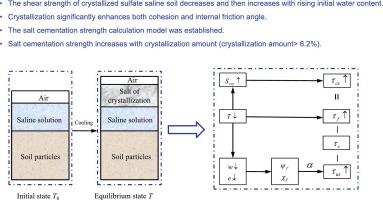Influence of cooling-induced salt crystallization on the shear strength of sulfate saline soils
IF 3.8
2区 工程技术
Q1 ENGINEERING, CIVIL
引用次数: 0
Abstract
Sulfate saline soils are widely distributed in Northwest China, where significant diurnal temperature fluctuations promote salt crystallization during cooling, even above 0 °C. This alters soil properties and poses challenges to engineering stability. To investigate this, the effects of salt crystallization on shear strength were systematically examined through theoretical analysis and laboratory direct shear tests. Crystallization significantly reduced void ratio and free water content while enhancing shear strength. The crystallized soil exhibited a unique shear strength pattern: an initial decrease, followed by an increase as the water content increased. Both cohesion and internal friction angles increased after crystallization. The cohesion progressively improved with higher crystallized salt content (>6.2 %), whereas the internal friction angle remained relatively stable. A corrected Bishop effective stress model was proposed to describe the process of increasing the strength of saline soil with an increase in crystallization amount, and it showed good performance.

冷却诱导盐结晶对硫酸盐盐渍土抗剪强度的影响
硫酸盐盐渍土在西北地区分布广泛,在降温过程中,即使在0℃以上,温度的日波动也会促进盐的结晶。这改变了土壤性质,对工程稳定性提出了挑战。为此,通过理论分析和室内直剪试验,系统考察了盐结晶对抗剪强度的影响。结晶可显著降低孔隙率和自由水含量,提高抗剪强度。结晶土表现出独特的抗剪强度规律:随着含水量的增加,结晶土抗剪强度先减小后增大。结晶后内聚角和内摩擦角均增大。随着结晶盐含量(> 6.2%)的增加,黏聚力逐渐增强,而内摩擦角保持相对稳定。提出了一种修正的Bishop有效应力模型来描述盐渍土强度随结晶量增加而增加的过程,该模型表现出较好的性能。
本文章由计算机程序翻译,如有差异,请以英文原文为准。
求助全文
约1分钟内获得全文
求助全文
来源期刊

Cold Regions Science and Technology
工程技术-地球科学综合
CiteScore
7.40
自引率
12.20%
发文量
209
审稿时长
4.9 months
期刊介绍:
Cold Regions Science and Technology is an international journal dealing with the science and technical problems of cold environments in both the polar regions and more temperate locations. It includes fundamental aspects of cryospheric sciences which have applications for cold regions problems as well as engineering topics which relate to the cryosphere.
Emphasis is given to applied science with broad coverage of the physical and mechanical aspects of ice (including glaciers and sea ice), snow and snow avalanches, ice-water systems, ice-bonded soils and permafrost.
Relevant aspects of Earth science, materials science, offshore and river ice engineering are also of primary interest. These include icing of ships and structures as well as trafficability in cold environments. Technological advances for cold regions in research, development, and engineering practice are relevant to the journal. Theoretical papers must include a detailed discussion of the potential application of the theory to address cold regions problems. The journal serves a wide range of specialists, providing a medium for interdisciplinary communication and a convenient source of reference.
 求助内容:
求助内容: 应助结果提醒方式:
应助结果提醒方式:


